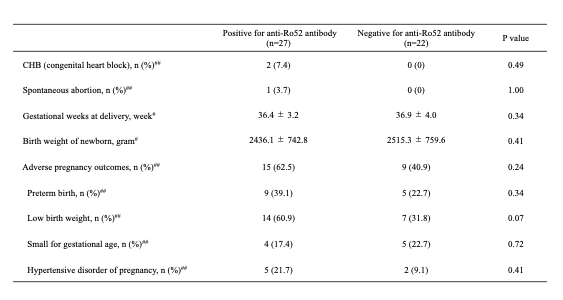Session Information
Session Type: Poster Session A
Session Time: 10:30AM-12:30PM
Background/Purpose: Anti-SS-A antibodies are associated with neonatal lupus erythematosus and congenital heart block (CHB). Ro/SS-A autoantigen is comprised of 52kDa Ro (Ro52) and 60kDa Ro (Ro60) protein, and antibodies for Ro52 has been shown to be particularly strongly associated with CHB [1]. However, relationship between the positivity of Ro52 antibody and anti-SS-A antibody titers, or pregnancy outcomes have not yet been fully clarified and controversial. Therefore, the purpose of this study is to clarify the association between anti-Ro52 antibody and pregnancy outcomes, including CHB, in anti-SS-A antibody positive patients.
Methods: We used the data of anti-SS-A positive patients who have been treated at the planning for pregnancy from a single center cohort of rheumatic disease pregnancy registry from 2007 to 2024. We analyzed the association between he titer of anti-SS-A antibody, anti-Ro52 antibody positivity and adverse pregnancy outcomes (APOs) such as CHB, preterm birth (PB) and low birth weight (LBW). Anti-Ro52 antibody was measured by enzyme-linked immune sorbent assay (Anti-SS-A 52 ELISA kit, ORGENTEC).
Results: Of the 256 pregnancies complicated with rheumatic diseases, 100 cases (39.1%) were positive for anti-SS-A antibodies, and mean titer of anti-SS-A antibodies was 981.0 ± 2625.9 IU/ml. Among these SS-A antibody-positive patients, 34 cases (34.0%) were diagnosed as primary Sjogren syndrome (SS). Of the 51 cases in which anti-Ro52 antibody could be measured, 27 cases (55.1%) were positive, and mean titer of positive cases was 62.3 ± 186.3 IU/ml. The titer of anti-SS-A antibody was significantly higher in anti-Ro52 antibody-positive cases (Figure 1a, P< 0.01), and the titer of anti-Ro52 antibody was strongly related with the titer of anti-SS-A antibody (Figure 1b, r=0.924, P< 0.01). In addition, logistic regression analysis for the positivity of anti-Ro52 antibody showed that the cut-off values for anti-SS-A antibody titer was 1041.1 IU/ml (Figure 1c, AUC=0.729, P< 0.01). Glucocorticoids (GCs) was administered in 58 cases (58.0%), and hydroxychloroquine (HCQ) was administered in 16 cases (16.0%). CHB was observed in 2 cases, both of whom had a high titer for anti-Ro52 antibody, neither GCs nor HCQ were administered. Live birth resulted in 90 cases (90.0%), and APOs occurred in 38 cases (38.0%), which included in 18 cases (20.0%) of PB and 30 cases (33.3%) of LBW. There was no significant difference on any APOs between positive and negative for anti-Ro52 antibody. On the other hand, only GCs dose during pregnancy was significantly associated with PB and LBW.
Conclusion: The titer of anti-SS-A antibody and the presence of anti-Ro52 antibody was not associated with the APOs such as PB or LBW. In anti-SS-A antibody positive pregnancies, it is important to assess and manage risks of neonatal lupus erythematosus, by testing for the presence and titer of anti-Ro52 antibody and changing in therapeutic agents.
To cite this abstract in AMA style:
Shimada H, Mino R, miyagi t, Ushio Y, Sugihara K, Mizusaki M, yamaguchi H, Manabe N, Nakashima S, Dobashi H. Significance of anti-Ro52 Antibody in Pregnancy Complicated with Anti-SS-A Antibody Positive Rheumatic Disease Patients [abstract]. Arthritis Rheumatol. 2024; 76 (suppl 9). https://acrabstracts.org/abstract/significance-of-anti-ro52-antibody-in-pregnancy-complicated-with-anti-ss-a-antibody-positive-rheumatic-disease-patients/. Accessed .« Back to ACR Convergence 2024
ACR Meeting Abstracts - https://acrabstracts.org/abstract/significance-of-anti-ro52-antibody-in-pregnancy-complicated-with-anti-ss-a-antibody-positive-rheumatic-disease-patients/



